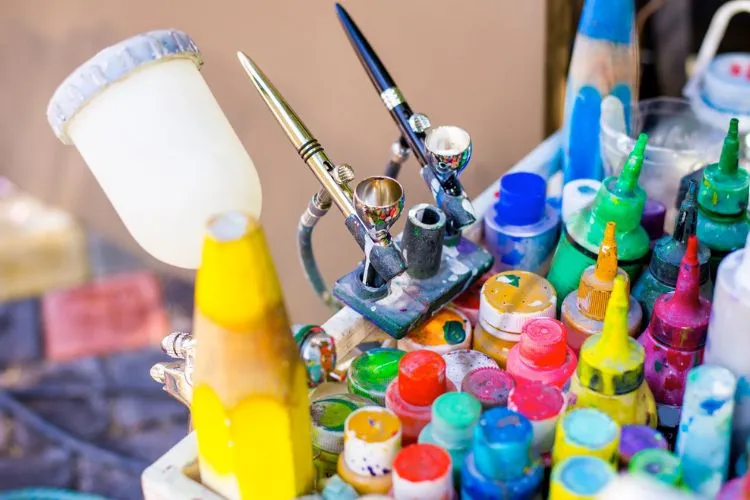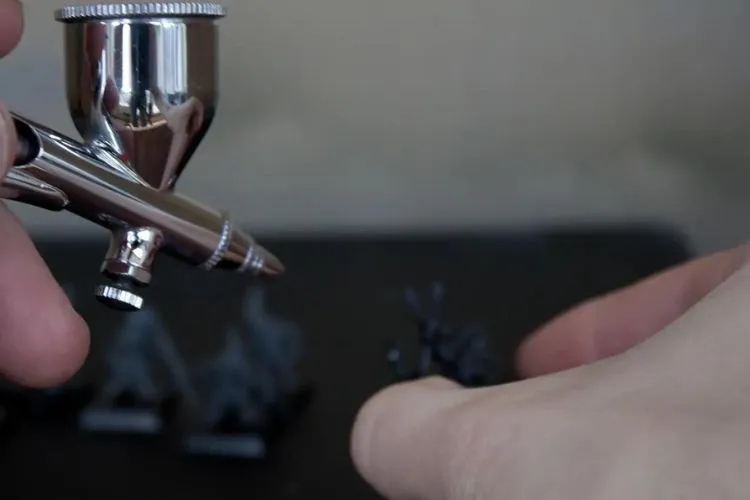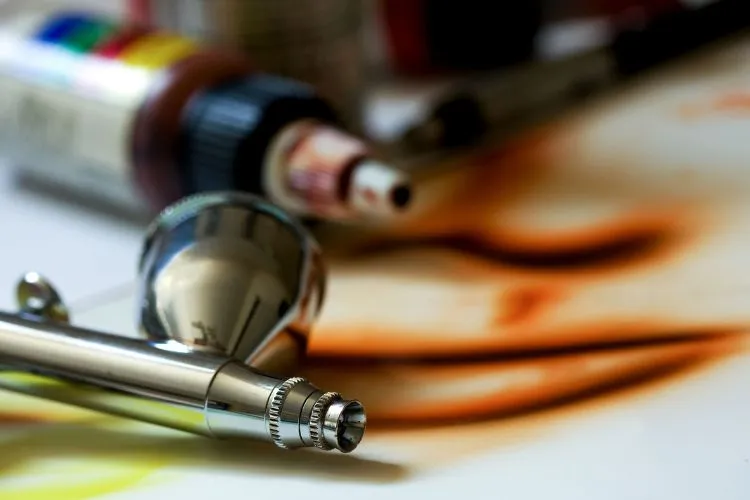Airbrushing is a technique that requires precision, control, and most importantly, the correct paint consistency. When using acrylic paints in an airbrush, it is vital to thin the paint to the right viscosity.
This article will guide you through the process of how to thin acrylic paint for airbrush, ensuring a smooth, even flow without clogging your equipment.

Understanding Acrylic Paint for Airbrushing
Acrylic paints come in various types and consistencies, from heavy body to fluid acrylics. Heavy body paints are thick and hold peaks, while fluid acrylics have a cream-like consistency.
For airbrushing, the paint needs to be thin enough to pass through the airbrush nozzle easily but thick enough to provide good color and coverage.
Desired characteristics in airbrushing include a paint that flows well but does not run. The paint should dry to a smooth finish without showing any texture from the airbrushing process.
Preparing Your Workspace
Before you start, gather all necessary materials such as acrylic paint, thinning medium, mixing containers, and your airbrush.
Ensure your workspace is well-ventilated to avoid inhaling fumes. Wearing a mask and avoiding skin contact with the paint and medium are good safety practices.
How to Thin Acrylic Paint for Airbrush?
Selecting the right tools, including paint, airbrush, and thinning mediums, is the first step. Your choice of acrylic paint should match the nozzle size of your airbrush for the best results.
Thinning medium options include water and professional acrylic mediums. While water is a cost-effective thinner, professional mediums offer benefits such as extended drying time and enhanced flow.
Mixing the Paint
To thin your paint, start with a small amount of paint in your mixing container. Add the thinning medium gradually, mixing constantly until you achieve the desired consistency.
A general guideline is to start with a ratio of one part paint to one part medium and adjust from there. The goal is to reach a milk-like consistency.
Testing the Mixture
Always test your thinned paint on a sample material before beginning your project. This practice helps you adjust the paint mixture if necessary.
If the paint is too thin, add more paint; if too thick, add more medium.
Cleanup and Maintenance
After each use, cleaning your airbrush thoroughly will extend its life and ensure it is ready for your next project. Leftover thinned paint can often be stored for a short period, depending on the medium used for thinning.
Troubleshooting Common Issues

Clogging is a common problem when airbrushing with acrylics. To avoid this, ensure the paint is thinned properly and the airbrush is clean.
Paint texture issues can usually be resolved by adjusting the paint to medium ratio. Uneven spray patterns may indicate the need for further thinning of the paint or cleaning of the airbrush.
Advanced Tips and Techniques
Experimenting with different additives can enhance the paint’s finish, transparency, or drying time.
Practicing different hand movements and airbrush distances from the surface can yield various effects, such as gradients and fine details.
Best Practices
Maintaining your airbrush and practicing regularly will improve your airbrushing skills and ensure the best results.
Testing different paints, thinners, and techniques will help you find the perfect combination for your projects.
Choosing the Right Airbrush for Acrylic Paints
Choosing the right airbrush is pivotal for achieving desired results with acrylic paints. Airbrushes primarily differ in their action and feed types. Single-action airbrushes are simpler, making them great for beginners and large, even coverage tasks.
In contrast, double-action airbrushes offer more control over both air and paint flow, allowing for intricate detail work and gradations.
When it comes to the feed, gravity-feed airbrushes are excellent for acrylics due to their efficient use of paint and ability to work at lower air pressures, which is ideal for finer details.
Siphon-feed models are better suited for larger projects requiring more paint volume. For acrylic paints, which can vary in viscosity, a gravity-feed, double-action airbrush is often the best choice, providing both the precision needed for detailed work and the versatility to handle different paint consistencies.
Safety Precautions for Airbrushing

When airbrushing, especially with acrylic paints, adopting proper safety precautions is crucial to prevent health risks. Wearing gloves protects your skin from direct contact with paint and solvents, which could cause irritation or allergic reactions.
Goggles are essential to shield your eyes from harmful aerosol particles, preventing irritation and potential damage. Additionally, protective clothing or a dedicated apron can keep your clothes free from paint splatters.
Working in a well-ventilated area is critical to avoid inhaling paint fumes, and when ventilation is inadequate, wearing a mask or respirator designed for paint fumes is advisable to protect your respiratory system.
You may also read: How to Make Acrylic Paint Dry Faster? Techniques and Tips
Frequently Asked Questions (FAQs)
Can I use regular tap water to thin my acrylic paints for airbrushing?
Yes, but professional mediums may offer better results in terms of flow and drying time.
How do I choose between water and a professional medium for thinning?
Consider the desired drying time and finish. Professional mediums can provide specific benefits that water cannot.
What do I do if the paint is still clogging the airbrush after thinning?
Try further thinning the paint or cleaning the airbrush, as clogs can occur from dried paint within the equipment.
How can I ensure the longevity of my airbrush while using acrylic paints?
Clean your airbrush thoroughly after each use and follow the manufacturer’s maintenance guidelines.
Are there any health concerns associated with airbrushing acrylic paints?
Always work in a well-ventilated area and consider wearing a mask to avoid inhaling fumes.
Conclusion:
Thinning acrylic paint correctly for airbrushing is crucial for achieving professional results. By following the steps outlined above, artists can ensure a smooth, even flow of paint without clogging, allowing for detailed and intricate designs.
Experimentation with different paints, mediums, and techniques is encouraged to discover optimal combinations for every project.

Meet Isabella Anderson, your acrylic painting mentor with over a decade of brush-wielding mastery. Dive into the colorful world of acrylics with her expert guidance, featured exclusively on ‘Acrylic Authority.’ Unleash your inner artist and explore the limitless possibilities of this versatile medium alongside a true acrylic aficionado.
